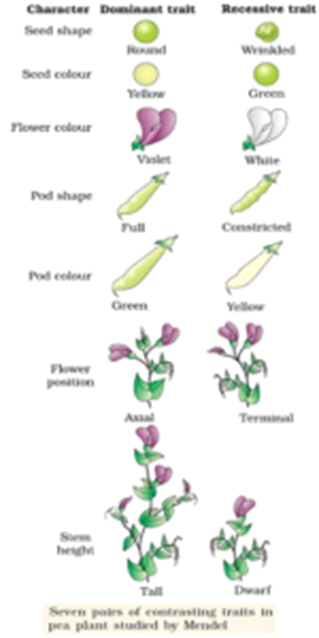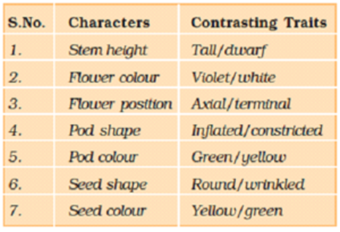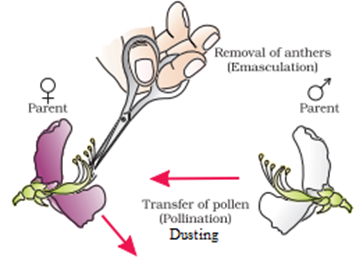Science > Biology > Genetic Basis of Inheritance > Mendel’s Monohybrid Cross Experiment
In this article, we shall study Mendel’s monohybrid cross experiment and its conclusions.
The first scientific explanation of inheritance was given by Mendel in 1866. He performed a series of experiments on garden pea in a scientific manner and proposed rules. which are called as Mendel’s Laws of Inheritance. His work is known as Mendelism. He laid down a foundation of Genetics hence he is called Father of genetics.
Reasons for Selection of Garden Pea by Mendel:
- Garden pea is an annual plant and completes the life cycle within three or four months. Due to this short lifespan, he was able to take three generations in a year.
- It is a small herbaceous plant that produces many seeds and so he could grow thousands of pea plants in a small plot behind the church.
- It is naturally self-pollinating and was available in the form of many varieties with contrasting characters. There were no intermediate characters.
- Flowers are large enough for easy emasculation required for artificial cross and produce fertile offspring.


The Reason of Success of Mendel’s Experiment:
- Mendel studied the inheritance of one character at a time whereas earlier scientists had considered the organism as a whole. Initially, Mendel considered the inheritance of one trait only. (Monohybrid). Then he studied two traits together (dihybrid) and then three (Trihybrid).
- He started with pure line i.e. true breeding. He maintained a complete statistical record by counting an actual number of offspring.
- He carried out experiments up to the second and third generations.
- He conducted ample crosses and reciprocal crosses to eliminate chance.
- He dealt with a large sample size.
Monohybrid Cross:
A cross between two pure (homozygous) patterns in which the inheritance pattern of only one of contrasting characters is studied is called monohybrid cross. It is a cross between two pure (obtained by true breeding) parents differing in a single pair of contrasting characters. The procedure is as follows:
Step – 1: Selection of parents and obtaining Pure lines:
He selected pure line plants by ensuring that the selected male (pure dwarf) and female parent plants (pure tall) are breeding true for the selected trait or traits by selfing them for three generations. Thus pure line plants are homozygous for a given trait.
Step – 2: Emasculation, Dusting and Raising F1 Generation (Hybridization):
Emasculation:
Emasculation is a process of removal of stamens before the formation of pollen grains (anthesis). This is done in the bud condition. The bud is carefully open and all stamens (9 + 1) are removed carefully. The stigma is protected against any foreign pollen with the help of a muslin bag.

Dusting and Raising F1 Generation:
The pollens from the selected male flowers are dusted on the stigma of an emasculated female flower. The cross-pollinated flowers were enclosed in separate bags (bagging) to avoid further deposition of pollens from another source. During the pollination, it was assured that the pollen is mature and the stigma is receptive. This is an artificial cross. Mendel crossed many flowers, collected seeds and raised F1 generation. The plants used as parents are said to represent parental generation and are designated as P1. The progeny obtained as a result of the crossing between parents is called the first filial (offspring) generation and is represented as F1. All plants of F1 generation were tall.
Punnett Square for F1 Generation:

T (tall) is a dominant character t (dwarf) is a recessive character.
Collection and Separation of Seeds:
Seeds were separated and collected in marked bottles. To study characters of seeds they are studied immediately but for other characters, seeds were sown to raise next generation (F2)of the plant.
Reciprocal Cross:
Mendel thought F1 Generation is tall because tallness character is given by female parent and dwarfness character is given by a male parent.
To counter check it he performed reciprocal cross. Now, He selected pure line plants by ensuring that the selected male (pure tall) and female parent plants (pure dwarf) are breeding true for the selected trait or traits by selfing them for three generations.
He got the same result as in the first case. From this, he concluded that tallness is a dominant character, while the dwarfness is the recessive character.
The plants obtained from the crossing of two individuals differing at least one set of characters are known as hybrids and the process of obtaining them is called hybridization.
Punnett Square for (Reciprocal Cross) F1 Generation:

T (tall) is a dominant character t (dwarf) is a recessive character.
Step – 3: Selfing of F1 hybrids to produce F2 Generation:
Mendel allowed natural pollination in each F1 hybrid; collected seeds separately and F2 generation (second filial) is obtained. The ratio of tall plants to dwarf plants in F2 generation is found to be 3: 1
Punnett Square for F2 Generation:

T (tall) is a dominant character t (dwarf) is a recessive character.
The ratio of tall plants to dwarf plants was around 3:1. Thus phenotype ratio (tall : dwarf) is 3: 1. The genotype ratio (pure tall : hybrid tall : pure dwarf) is 1:2:1.
Step – 4: Self Breeding:
Mendel carried self-breeding among F2 generations and obtained F3, then F4 generations.
Checking With Other Traits:
Mendel performed monohybrid crosses and reciprocal crosses with all the seven pairs of contrasting characters separately and obtained similar results.
Only one of the two characters was expressed in F1 generation. In F2 generation the character which was shown in F1 generation was in large number and the other in small number and the ratio was found to be 3:1. This ratio is called the monohybrid ratio.
Genotype Ratio for Monohybrid Cross:
The ratio of pure dominant character to hybrid character to pure contrasting recessive character is called the genotype ratio. In monohybrid cross experiment the genotype ratio for F2 generation is 1:2:1.
Monohybrid Ratio for Monohybrid Cross:
Monohybrid ratio is defined as the phenotypic ratio of different types of offsprings (dominant and recessive) obtained in F2 generation of a monohybrid cross. In monohybrid cross experiment the phenotype ratio for F2 generation is 3:1.
Mendel’s Conclusions for Monohybrid Cross:
- Characters such as a height of a stem, a color of seed etc. are inherited separately as discrete particles or unit. He called them a factor or a determiner. Now it is called a gene.
- Each factor exists in contrasting or alternative forms. For e.g. for the height of a stem, there are two factors one for the tallness and other for the dwarfness. These two forms of genes are called alleles.
- One of the factors is dominant and another factor is recessive. The only dominant factor expresses in the F1 generation.
- In an organism, inheritance of each character is controlled by a pair of factors. One of the factors is contributed by the male parent and the other by the female parent. Thus higher organisms are diploid (2n)
- From F2 generation Mendel concluded that in hybrid the two factors do not mix together but they just remain together.
- During gamete the formation, they separate or segregate and each gamete receives only one factor from each pair of factors. Thus gametes are haploid (n).
Diagrammatic Representation of Monohybrid Cross

Test Cross or Back Cross:
This is the method devised by Mendel to test the genotype of F1 Hybrids. In F1 generation 25% of plants are dwarf and we can definitely say that their genotype is ‘tt’ (Homozygous). But in the case of a tall plant, there are 25 % pure tall plants and 50% hybrid tall plants. Hence in the case of tall plants genotype can be ‘TT’ (Homozygous) or ‘Tt’ (Heterozygous). Thus we are not sure of the genotype of tall plants in the F1 generation.
In a test cross, F1 hybrid is crossed with the homozygous recessive parent. Thus the offspring is crossed back with the parent, hence the test cross is also called a back cross.

If offspring has genotype (TT) then the F2 generation obtained will be 100 % tall. It can be explained as follows. The recessive parent can produce only one type of gamete ‘t’, and the offspring of the first generation can produce only one type of gamete ‘T’. Thus the progeny (F2 generation) will have genotype ‘Tt’ (tall).
If offspring has genotype (Tt) then the F2 generation obtained will be 50 % tall and 50 % dwarfs. It can be explained as follows. The recessive parent can produce only one type of gamete ‘t’, while the hybrid of the first generation can produce two types of gametes ‘T’ and ‘t’. Thus half the progeny (F2 generation) will have genotype ‘Tt’ (tall) and remaining half ‘tt’ (dwarf).
Diagrammatic Representation of Test Cross (With Flower Colour):

A test cross is a back cross but a back cross is not necessarily a test cross:
Case – 1: When the F1 generation is crossed with Recessive Parent:
The recessive parent can produce only one type of gamete ‘t’, while the hybrid of the first generation can produce two types of gametes ‘T’ and ‘t’. Thus half the progeny (F2 generation) will have genotype ‘Tt’ (tall) and remaining half ‘tt’ (dwarf).
Case – 2: When the F1 generation is crossed with Dominant Parent:
The dominant parent can produce only one type of gamete ‘T’, while the hybrid of the first generation can produce two types of gametes ‘T’ and ‘t’. Thus 100 % progeny is tall. half the progeny will have genotype ‘TT’ (Pure tall) and remaining half ‘Tt’ (Hybrid tall).
A test cross is a cross used to find the genotype of F1 generation. The test cross is a cross between an individual with the unknown genotype for a particular trait with a recessive plant for their trait, While back cross is a cross between an individual with the unknown genotype for a particular trait with a recessive or dominant plant for their trait. Back cross can not indicate the genotype of F1 generation. Hence a test cross is a back cross but a back cross is not a test cross.
The test cross method can be used to introduce useful recessive traits. Which is important in rapid crop improvement programmes.
One reply on “Mendel’s Monohybrid Cross Experiment”
It is helpful for everyone nice website 💗💗💖💞💝💖💗💥💥💣💣💥💢❣️💦💨💨